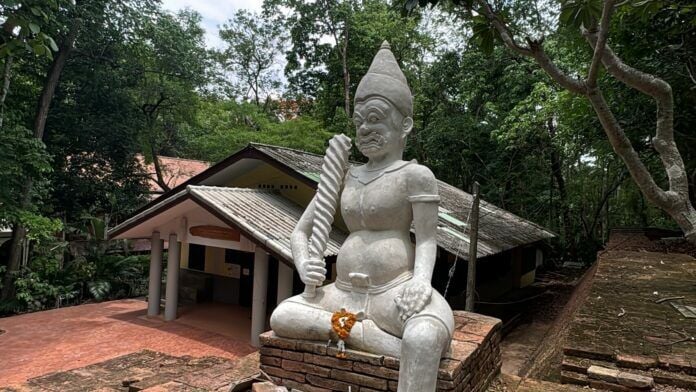The Chiang Mai governor coordinated with the Fine Arts Department to restore a 400 year old giant statue at a prominent historical temple, sparking criticism from an academic who argues that the restoration was inappropriate.
The controversy began when an assistant professor at the Faculty of Fine Arts at Chiang Mai University, Surachai Jongjitngam criticised the restoration of a large Lanna-style giant sculpture at Wat Umong Suan Phutthatham in Chiang Mai.
The restoration involved covering the ancient statue with new plaster, making it appear entirely new.
The original sculpture, although partially damaged, was still largely intact with its head and torso preserved. The arms were slightly damaged but the sculpture remained a valuable piece of Lanna art.
Lanna giant sculptures in such good condition are rare and serve as important models for studying Lanna art, which has unique characteristics distinct from Ayutthaya and Rattanakosin art found in Bangkok.
Despite its historical significance, the statue was recently covered with new plaster by modern craftsmen who may not have appreciated its ancient value. This action transformed the ancient giant into a completely new piece.
The restoration was ordered by Chaing Mai Governor, Nirat Pongseethithaworn who entrusted the temple abbot with overseeing the restoration.
Today at 11am, Nirat clarified the situation and mentioned that in early April of the previous year, he visited the temple and noticed the damaged statues which prompted a collaboration with the Fine Arts Department for their restoration, which was completed several months ago.
Tourists were commenting on the neglect, prompting him to contact the Fine Arts Department, which specialises in historical artefacts.
Asst. Prof. Surachai commented on the incident, saying he would not judge who was right or wrong, acknowledging that restoration is generally positive.
However, he felt this particular restoration was inappropriate. He noted that although the Fine Arts Department’s efforts were not incorrect, the method chosen did not suit the context as it erased the ancient appearance of the statue.
He finds that covering the old plaster with new material erased the statue’s historical character, reported Khaosod.
The debate highlights the complexities involved in restoring ancient artefacts and balancing preservation with respect for their original state. The incident underscores the need for careful consideration and expertise in handling historical restorations to maintain their authenticity and historical value.
Chiang Mai NewsThailand News



